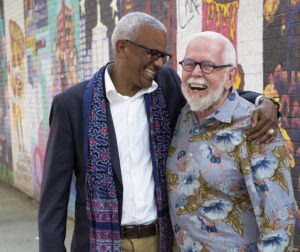Habilitation approach to dementia care focuses on remaining abilities
Focusing on helping those with advanced dementia use the skills and abilities they still possess is the primary goal of habilitation therapy, William Kirkpatrick, LICSW, explained in a recent phone call convened by the Centers for Medicare & Medicaid Services (CMS) National Partnership to Improve Dementia Care in Nursing Homes. Kirkpatrick detailed the approach as well as an effort to educate long-term care workers on how to train others in Maine, where he is program director of the state chapter of the Alzheimer’s Association.
The habilitation approach to dementia care was developed about 20 years ago by Paul Raia, PhD, vice president of clinical services for the Massachusetts and New Hampshire chapter of the Alzheimer’s Association, in collaboration with dementia care consultant Joanne Koenig Coste, author of “Learning to Speak Alzheimer’s,” Kirkpatrick said in the Dec. 9 call. The therapy is designed “to promote a positive emotion in a person with dementia, focusing on their strengths and minimizing limitations,” he said. “And so the differentiation is that we’re really focusing on in habilitation, not rehabilitation. We want to avoid focusing on abilities that the individual has lost.”
The five areas where communities and professional caregivers can use habilitation therapy to make a change that will lead to a positive emotional response in someone with dementia, Kirkpatrick said, include:
- Communication. Words, body language and nonverbal communication become increasingly important.
- The physical environment. “We really think about and talk about the importance of, the influence of, the physical environment.”
- The approach to personal care—“really keeping the person with dementia in the middle and the focus in terms of our approach to care.”
- Purposeful and meaningful engagement throughout the day—“giving the person with dementia a sense of purpose and belonging.”
- Behavior as communication. When speaking is difficult, behavior becomes the way to communicate. Caregivers use a “behavior log” of sorts to identify behaviors and internal or external triggers to behaviors that need to be responded to.
“We want to use those techniques and methods that are appropriate and would fit in any environment or with any setting, any staffing ratio or even in a home care setting by tapping into the best practices within the five domains,” Kirkpatrick said.
Raia, Kirkpatrick said, is involved in a CMS-related project gathering evidence-based data on the use of habilitation therapy in Massachusetts nursing homes. “My understanding preliminarily is that there are some significant outcomes to that research that demonstrate the influence or the positive effect of habilitation therapy,” he added.
Training the trainer
The “train the trainer” curriculum used by Kirkpatrick, which formally is called “Caring for People with Alzheimer’s Disease: A Habilitation Training Curriculum,” updates the habilitation approach for a broad spectrum of audiences.
Kirkpatrick said that he and the executive director of the Maine Chapter of the Alzheimer’s Association, Laurie Trenholm, became trainers about two and a half years ago. Since that time, they’ve educated more than 90 people who work in nursing homes, assisted living communities, home care agencies, adult day care programs, hospices and group homes or agencies that are providing care for developmentally disabled individuals. They have revised the training based on feedback from participants and offer it five or six times a year throughout the state. Five of the six New England chapters of the Alzheimer’s Association, and “two or three others,” have adopted the training model, Kirkpatrick said.
“The training essentially is inviting individuals with dementia care experience who have responsibility in their agencies or facilities to provide training or in-service training to their staff,” Kirkpatrick said. “They are then certified—small c—and authorized to use this curriculum within their facility. [The certification] is not transferable in terms of being able to use the training curriculum to train any other individual outside of the scope of their job or their responsibilities within the agency [or facility]. However, if the individual transfers [or] moves from one job to the other, they would still have that approval to use the curriculum to train for their staff.”
The seven-hour training covers 13 hours’ worth of curriculum, Kirkpatrick said, including the five aforementioned areas as well as understanding and working with families. An addendum covers Alzheimer’s and sexual behavior.
The curriculum can be adapted according to the make-up of a facility’s staff, he said. “The Alzheimer’s Association requires 12 hours for direct care workers, with a recommended 13th hour on the family module,” Kirkpatrick added, “and we recommend two hours of training for ancillary staff,” including understanding of Alzheimer’s and dementia. “The ancillary staff, we think, will also benefit from learning the two hours on communication,” he said.
The training is “very flexible and user-friendly,” Kirkpatrick said. “The flexibility carries on in terms of how trainers put together the modules or facilitate the training over time. Some trainers have provided training at the time of shift change for one-hour sessions and then followed through training for 12 weeks. …Other trainers have required staff to attend two six-hour training sessions on back-to-back days, for instance. The ideal may be to offer four weekly three-hour training sessions for direct care staff and one two-hour training for ancillary staff. But the curriculum is flexible enough to really be utilized in any particular respective agency or facility.”
The Dec. 9 call also included a lengthy discussion of Comfort Matters, a palliative care approach for those with advanced dementia.
Related content:
Comfort focus improves lives of those with advanced dementia
Related Articles
Topics: Alzheimer's/Dementia , Articles











